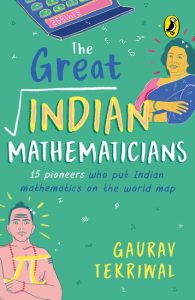
India’s mathematicians have made significant contributions over the last 5000 years. From the ever-popular Aryabhata, widely recognized for revolutionizing the number system and Shakuntala Devi, universally admired for her fast mental calculations to pioneers forgotten by time, like Baudhayana, who explained the Pythagoras’ theorem nearly 3000 years ago, India has produced many trailblazers in the field of mathematics.
Here are the stories of three such inspirational figures whose passion for knowledge and love for maths not only earned them worldwide acclaim but also brought prestige to the country.
Madhava – He is considered the greatest mathematician-astronomer to emerge from medieval India whose works laid the foundation for the Kerala School of Mathematics, which flourished between the late 14th century and the 18th century.
Madhava was a genius. He went a step ahead and linked the idea of an infinite series with geometry and trigonometry. He even obtained a way to calculate the value of pi correct to 13 decimal places, and this was two centuries before Gottfried Wilhelm Leibniz, a polymath from Germany.
It is perceived that Newton and Leibniz independently found the methods of calculus by building on and borrowing from the works of mathematicians like Fermat, Taylor, Gregory, Pascal and Bernoulli. But what is not known is that the elements of calculus were already known in Kerala, India, for over 250 years. The West has now recognized this and accordingly renamed some results regarding the trigonometric series, previously known as the Newton, Gregory and Leibniz series, as the Madhava-Newton, Madhava- Gregory and the Madhava-Leibniz series, respectively.
Srinivasa Ramanujan – During his short life, Ramanujan independently compiled over 3900 identities and equations, which have all been proved by later mathematicians. This contributed to breakthrough research in mathematics and remarkable discoveries in crystallography and string theory.
It was in January 1913 that Ramanujan wrote the famous letter to an English mathematician Prof. G.H. Hardy of Cambridge University with numerous theorems he had researched and worked upon himself. Hardy was initially skeptical of Ramanujan’s work assuming that he was a fraud but soon had to change his mind as he went through the theorems given in the letter. He finally concluded that Ramanujan was ‘a mathematician of the highest quality, a man of altogether exceptional originality and power’. Hardy then immediately made arrangements to invite Ramanujan to Cambridge University from India.
Ramanujan was elected as a member of the London Mathematical Society in 1917 and the next year, in 1918, Ramanujan was elected as a Fellow of the Royal Society—the youngest ever at thirty-one years of age.
Shakuntala Devi – was India’s iconic ambassador in the field of mathematics and travelled the world enthralling audiences with her number-crunching prowess.
She was found displaying exceptional memorization skills by her father while he was showing her card tricks. She was only three at the time. At six, the young wonder, Shakuntala Devi started travelling with her father, doing roadshows, where she displayed her unique calculation abilities of large multiplications, cube roots of huge numbers and even questions related to dates! In 1980, at the Imperial College of London, she rose to meteoric success and global fame by multiplying two 13-digit numbers in 28 seconds flat.
In her book In the Wonderland of Numbers, she wrote ‘As for numbers, they hate nobody, and nobody can afford to hate them!’ She continues to give us hope that mathematics can also be fun and exciting and that it is essential to approach it with a spirit of curiosity!
*

To know more about India’s finest mathematicians, read The Greatest Indian Mathematicians. It is an ideal introduction for the next generation of tenacious and curious maths wizards.









